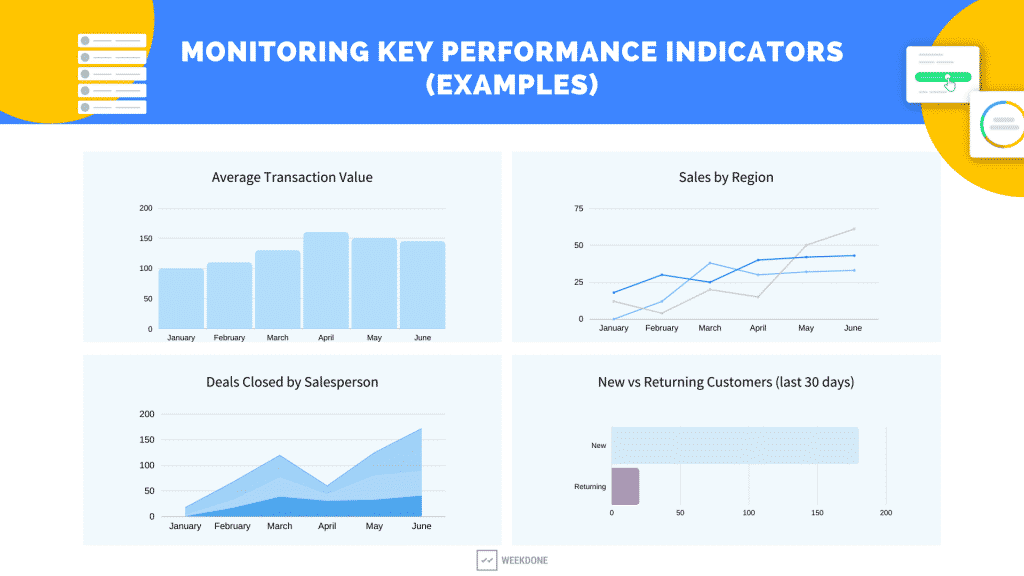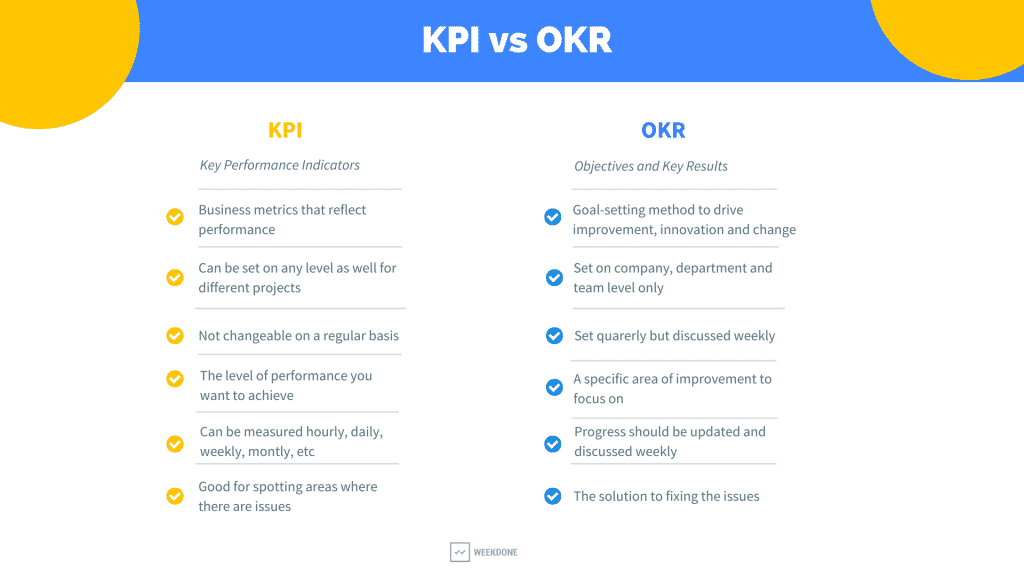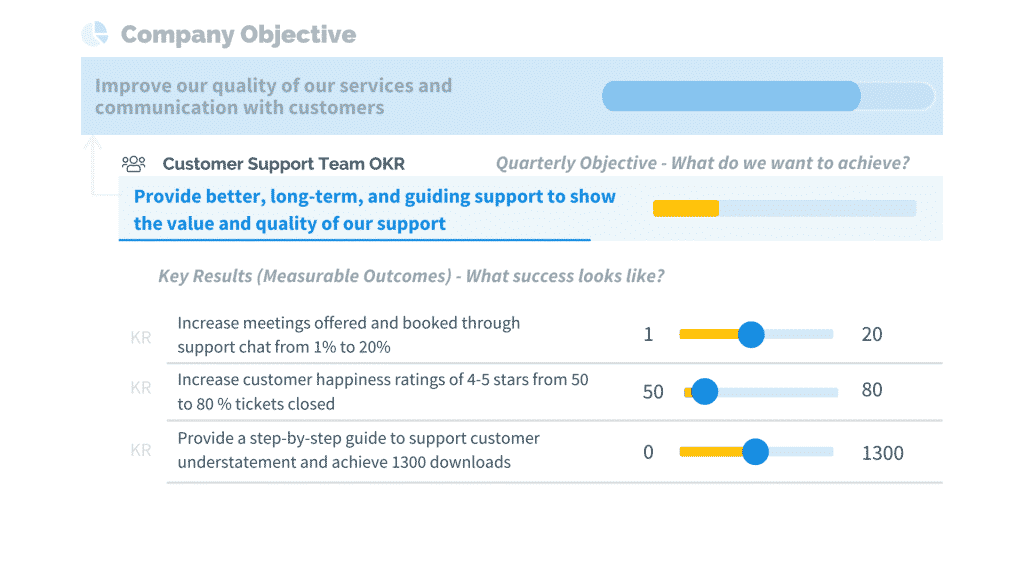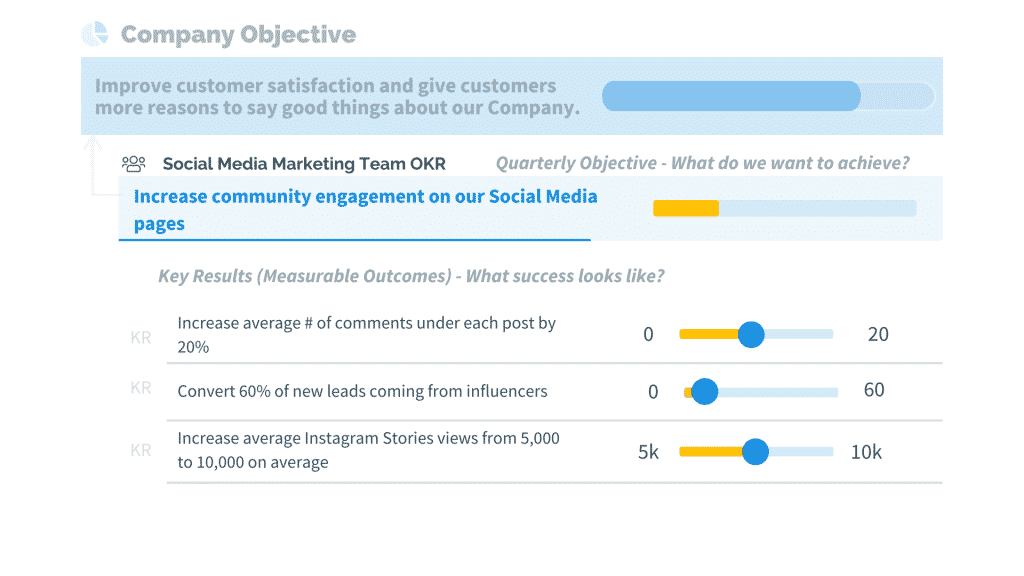If you have ever raised one of the questions below, make sure to read this article as it will help you manage your goal-setting process much better.
- Do we need both OKRs and KPIs, or one of them will do?
- Can we use KPIs in our Key Results or in Objectives?
- How do we switch from KPIs to OKRs?
It’s important to know the right answers to these questions because OKRs and KPIs serve different purposes. You need both KPIs and OKRs to make sure you have a well-performing and continuously improving company.
What is a KPI
Key Performance Indicators (aka business metrics or performance targets) are numbers that show you if you are maintaining a healthy business. KPIs have targets (expected performance level) so you would know what are the criteria for “healthy”.
In most companies, KPIs reflect revenue targets and month-on-month growth of various business metrics. You can track all of your regular business activities with KPIs, i.e.:
- revenue,
- customer acquisition cost,
- changes in website traffic,
- ROI,
- market share,
- employee turnover rate,
- customer satisfaction,
- number of new and recurring purchases,
- sales by region,
- a number of daily meetings you have with potential clients, etc.
These targets can be annual, quarterly, monthly, daily, or even hourly, depending on what you wish to keep an eye on.
They direct your attention toward what they are monitoring, and they simply tell you if you are achieving your targets or not. KPIs can be set to measure performance on the company, department, team, and also individual levels.
KPIs are usually achieved with business-as-usual activities and as a part of the daily routine. In other words, when people are keeping up with their regular tasks and completing them on time, they should be achieving these targets.
Analyzing your performance against KPI targets allows you to understand how to keep your business going. Simply put, to have a well-functioning company you need KPIs to keep an eye on its health.
💻 KPIs can be added to Weekdone. Read more here.

However, having these metrics doesn’t really tell you directly how to improve them. You cannot grow a business by simply saying “we need to hit a higher revenue target”. And if you’re falling behind on your KPI targets, what exactly do you need to improve to put everything back on track?
This is where OKRs come in. While KPIs are good for monitoring how the company is performing, OKRs are good for driving improvements in the areas that are falling behind or could use some extra attention.
🎥 Video learning: Why KPIs and projects are not enough to drive the business forward.
Quick knowledge check:
What is an OKR
OKRs in business are used to drive growth, improvement, and innovation. This goal-setting method is about singling out the focus areas that need more attention and work to drive the business forward.
You cannot switch from KPIs to OKRs as they are not interchangeable and their purpose is completely different.
Simply put, KPIs help you monitor if your ship is working well and how many kilometers are left to the destination port. While OKRs will help you focus on what needs to happen to actually steer the ship towards the destination.
Do you see what we mean? KPIs won’t improve your business, nor will they drive impactful changes.
It’s like measuring your blood pressure, you will simply see how much it is and if it meets the standards. If you are not happy with the results, you need to think about how can I change them for the better? What do I need to improve and how do I know if I am improving? That’s what OKRs are for.

🎥 Video learning: How OKRs are different and how to use them?
Quick knowledge check:
How do KPIs and OKRs work together
While KPIs are business metrics that reflect performance, OKRs are a goal-setting method that helps you improve performance and drive change. So KPIs let you know what you need to analyze to determine the basis for your OKRs.
There are two specific instances when a KPI number suggests that an OKR is needed to address a particular issue:
- If you’re falling behind on your KPI target, you need an OKR to put everything back on track.
- If you want to achieve a more ambitious KPI target (like a big revenue number), you need OKRs that will guide you there.
Let’s go through real-life examples to see how this works.
1) KPIs as “Health metrics” show in which areas you might have problems you need to solve
Do you know how much money your business is capable of making on a monthly basis? That is your monthly revenue KPI, and if your target is $100,000, you would deem yourself in good shape if you were hitting it each month.
If suddenly revenue drops to $90,000 and stays there month to month, you would direct your attention to this and start digging into the “why”. You will check if any other KPIs are performing low and here it is, it seems that Net Promoter Score (NPS) has dropped from 8 to 6.
So your KPIs (NPS and Revenue) are telling us that we do have a problem with making our customers happy and it’s affecting how much money we make. The logical next step is to figure out why the customers seem to be unsatisfied? How can we change that?
So a sudden drop in your KPI suggests that you need an OKR to improve a particular area in your business.
KPIs as business-as-usual growth targets help to specify expectations for performance.
This is where the whole OKR brainstorming process starts. The goal is to:
- Find what seems to be the problem
- Set a an OKR to drive improvements that solve the problem
💡 Read more about the process of setting good Actionable Objectives and Measurable Key Results.
Let’s say that in this case, the source of the low NPS and Revenue was the overall quality that customers experience. OKR in this case could look like:

Depending on the number of problems, it might take many quarters and solving multiple bigger problems before you see the KPI hitting its target again. But if after some time you don’t see any peak in the performance, you should question if you chose to focus on the right improvement areas.
Quick knowledge check:
2)OKRs help the company improve to achieve ambitious KPI targets
Low performance of certain KPIs is not the only reason to write improvement-focused OKRs. When you are doing good, you might want to be doing even better.
Let’s continue with our revenue example. Only this time the revenue is not falling behind but the company wants to propel growth and the leaders decided to set a very ambitious revenue target. It seems obvious that if you continue doing what you do know, it’s not really going to happen.
Most leaders find it very tempting to write a Company level Objective as: Increase revenue or Improve sales numbers. But just a wish to make more money is not enough. What would you need to improve, change, and rethink as a company to drive that growth?
Would you consider expanding your business to a new market, or increasing revenue per customer, or leveraging unconventional marketing channels, or looking for new audiences?
Let’s say that your business relies strongly on customer reviews and word of mouth. In this case, you could focus on improving the quality of your service and making customer satisfaction your competitive advantage, but also give your fans more reasons to talk about you. Customer satisfaction leads to better reviews, higher retention numbers and it seems like a good way to bring in more revenue.
In that case, Company level Objective might be: Improve customer satisfaction and give customers more reasons to say good things about our company.
There are many things the teams can do to ensure that the Company truly stands out in this area:
- Marketing can adjust the messaging and push a new communication campaign,
- Product Development can implement a new onboarding flow focusing on incorporating customer feedback,
- Business Development can choose new partners and affiliates with customer satisfaction in mind, etc.
Your Social Media Marketing Team might consider an OKR like:

If people spread the word and their excitement, along with good reviews about your service, it should attract more potential customers, increase the number of new deals, and eventually impact your revenue numbers. This is how you would start moving towards your ambitious KPI target.
🎥 Video Learning: Even though OKRs should have an impact on your KPIs and KPIs shouldn’t be your Key Results.
As you can see, KPIs and OKRs actually work together quite nicely: KPI being a starting point of a conversation about improvements to implement or problems to solve, and OKR specifying a focus area and measurable outcomes to be achieved to deliver on those improvements.
Remember, that while your team has OKRs, they can and should still keep an eye on their KPIs. For our Social Media team, those metrics could be the number of followers and leads they bring to the website. Those two areas should always be performing as expected.
Key Takeaways
There shouldn’t really be the word “versus” between OKR and KPI since they do not compete for your preference. They coexist very well and you should use both frameworks in your business but for completely different purposes. Use OKRs for goal-setting and improving your business and KPIs for monitoring general business performance.
Many companies choose to track their KPI targets in a spreadsheet where you can be as detailed as needed: Company KPI -> Department KPI -> Team KPI -> Individual KPI, and track those per year, quarter, month, week, day, or even per hour. Or you can also show them in your Weekdone account with the KPI feature.
For improvement-oriented and focused goal-setting, you should use OKRs. The OKR methodology offers great benefits for organizations by giving a framework and process that helps teams to learn what drives them forward.
